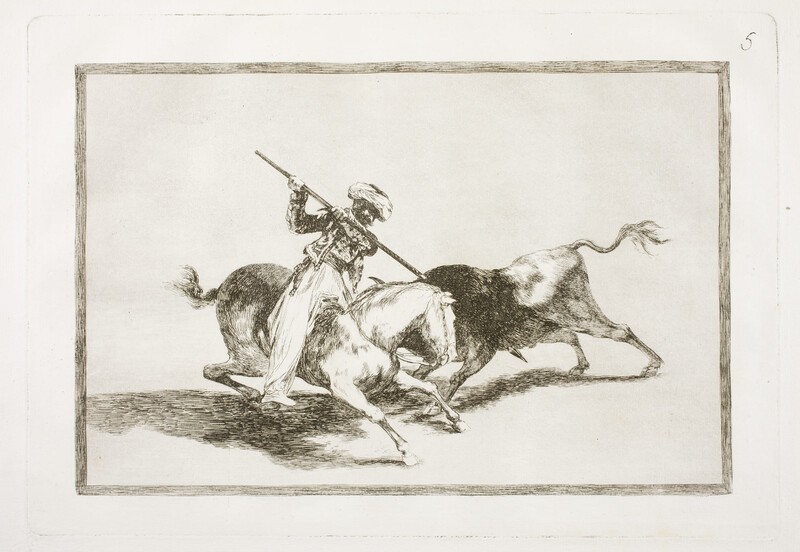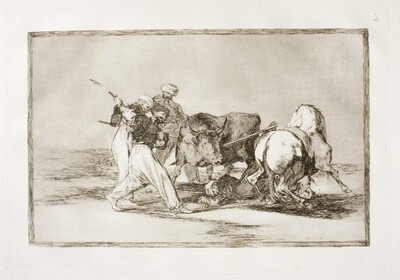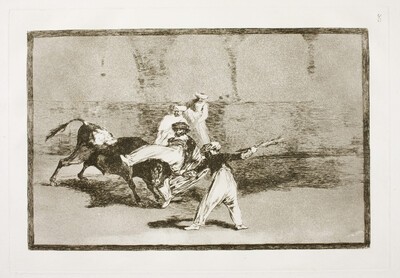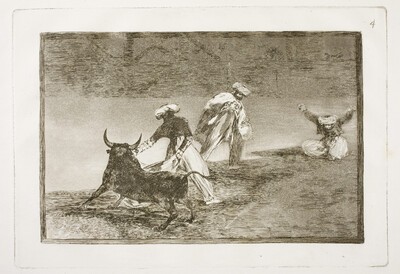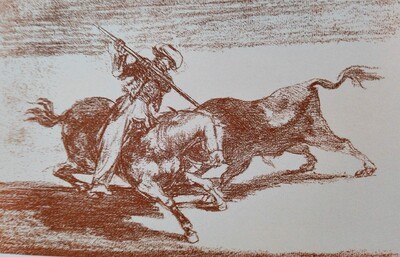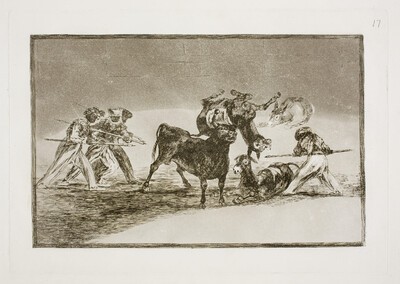- Cronología
- 1814 - 1816
- Dimensiones
- 246 x 353 mm
- Técnica y soporte
- Aguafuerte, aguatinta, punta seca y bruñidor
- Reconocimiento de la autoría de Goya
- Documented work
- Ficha: realización/revisión
- 01 Oct 2021 / 22 Jun 2023
- Inventario
- -
5 (print, upper right-hand corner)
See How the ancient Spaniards hunted bulls on horseback in the countryside
A state proof made before the aquatint was applied is preserved. Harris mentions proofs prior to the first edition with similar characteristics to this state proof.
The plate is kept at the National Chalcography.
See How the ancient Spaniards hunted bulls on horseback in the countryside
The print is part of the subgroup, within the group of "historical" scenes of bullfighting (Nos. 1-11), dedicated to the bullfighting of the Moors (Nos. 3-8 and 17). It depicts a fight scene between the Moor Gazul, who is on horseback, and a bull that is charging him. Gazul is stabbing the bull with both hands with a spear that pierces through the bull's lower part. The horse has one of its hind legs practically bent and is turned, looking at the bull. Goya uses a marked contrast of light, with very marked light and shadow, against a totally white background.
Gazul has been depicted as a Turk or Mamluk of the Napoleonic army. There is no agreement on the historicity of this character, who some authors place at the court of the king of Seville in the years 1050-1090, and others relate to legendary Moorish romances set in Granada in the 15th-century.
Lafuente Ferrari classifies this scene among those that narrate the beginnings of bullfighting and considers that it would illustrate the famous bullfighting text by Nicolás F. de Moratín, as well as comparing the posture of the protagonist with that of How the ancient Spaniards hunted bulls on horseback in the countryside.
Martínez-Novillo links this print with others of a chivalric theme, such as Charles V lancing a bull in the bullring of Valladolid.
Several authors, including Harris, Gassier and Lafuente Ferrari, state that there is a previous drawing of this print, also entitled The courageous Moor Gazul is the first one to lance bulls properly, which belonged to Yriarte and was published in the magazine L'Art (1877, volume II, p. 79), but whose whereabouts are unknown at present.
Tomlinson relates the print to Manet's painting Victorin Meurent in Sword Costume, in which the scene of the engraving appears in the background of the portrait..
There are certain bald spots on the blacks, especially on the bull, which can be seen in the printings from 1855 onwards and which are probably related to some accident on the plates or to clumsily executed retouches.
-
Grabados y dibujos de Goya en la Biblioteca NacionalBiblioteca NacionalMadrid1946catalogue Elena Páez Ríos
-
Goya en la Biblioteca Nacional. Exposición de grabados y dibujos en el sesquicentenario de su muerteBiblioteca NacionalMadrid1978May - June 1978
-
Grabados de Goya: colección propiedad de la Biblioteca Nacional, que se conserva en su Gabinete deCasa de la Amistad de MoscúMoscow1979exhibition displayed from January 18th to 31st 1979
-
1984
-
Madrid1987
-
Madrid1990
-
Goya grabadorFundación Juan MarchMadrid1994consultant editors Alfonso E. Pérez Sánchez and Julián Gállego, from January 14th to March 20th 1994
-
Goya grabadorMuseo del Grabado Español ContemporáneoMarbella1996from March 8th to May 5th 1996
-
Zaragoza1996
-
Schlaf der Vernunft. Original radierungen von Francisco de GoyaMunich2000
-
Madrid2002
-
Madrid2002
-
Bilbao2012
-
Zaragoza2017
-
1946pp. 177-216, espec. pp. 185 y 189
-
OxfordBruno Cassirer1964vol. II, 1964, pp. 318, cat. 208
-
Vie et ouvre de Francisco de GoyaParísOffice du livre1970p. 277, cat. 1157
-
Goya, toros y torerosMadridMinisterio de Cultura, Comunidad de Madrid1990p. 88, cat. 19
-
MadridCaser-Turner1992pp. 30 y 39
-
MadridMuseo Nacional del Prado2001pp. 48-50
-
Goya. In the Norton Simon MuseumPasadenaNorton Simon Museum2016pp. 186-201
